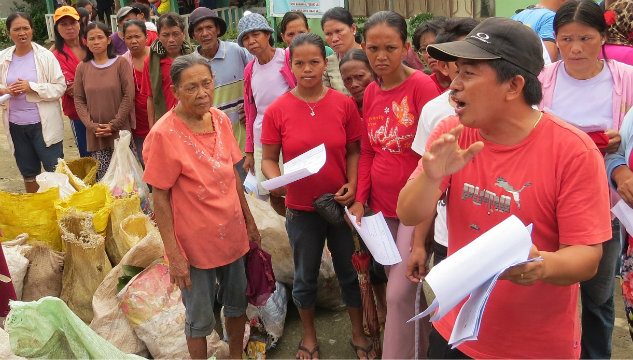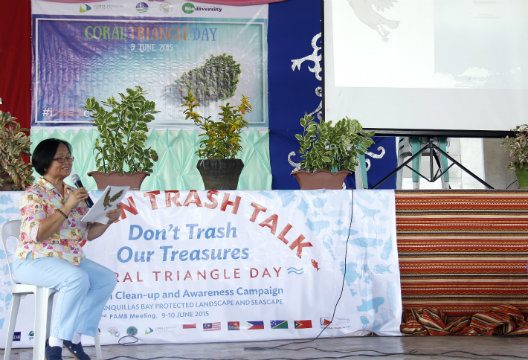SUMMARY
This is AI generated summarization, which may have errors. For context, always refer to the full article.

MANILA, Philippines – More than 4,000 volunteers helped clean up approximately 140 kilometers of beaches in the Dumanquillas Bay Protected Landscape and Seascape (DBPLS) to celebrate the Coral Triangle Day on June 9, 2015.
This is the first time that the 6 coastal municipalities surrounding the protected area converged for one goal: to promote trash-free seas.
The area stretches to almost 30,000 hectares and covers the provinces of Zamboanga del Sur and Zamboanga Sibugay. The municipalities of Lapuyan, Kumalarang, Margosatubig, and Vicenzo Sagun, Buug, and Malangas and its 42 barangays surround the bay.
Dumanquillas Bay serves as a nursing ground for tuna and other commercially important pelagic fishes such as sardines. Around 50% of the total coastal household income come from the extraction of marine resources. The bay feeds not only the families in Zamboanga but also the rest of the Mindanao area.
The strong support of the provincial and local government helped mobilize multi-sectoral groups during the event. These included schools, local government offices, law enforcement agencies, and civil society organizations, among others. Almost half of the volunteers were young, from elementary school pupils to students from high schools and universities.
“I’m amazed that most of the volunteers are from the youth,” says Bryan Bitantos, an instructor from the College of Forestry and Environmental Studies in Mindanao State University.
“I’m happy that the lessons from school about environmental protection have grown on them and now they can be good stewards of the coasts,” he added.
Protect the seas and coasts
The Coastal and Marine Resources Management in the Coral Triangle – Southeast Asia (CTI-SEA) project, funded by the Asian Development and the Global Environment Facility, organized the simultaneous bay-wide cleanup.
The project partnered with the Bureau of Fisheries and Aquatic Resources (BFAR), the Department of Environment and Natural Resources (DENR), the Protected Area Management Bureau (PAMB) of the DBPLS, and local government leaders to organize the event.
The activity contributed to the global effort of protecting the oceans. After segregating the trash, volunteers filled out trash data forms which will be reported to Ocean Conservancy’s International Coastal Cleanup movement, the world’s largest volunteer effort on behalf of ocean health.
An awareness-raising event in the town of Margosatubig followed the cleanup. Through short lectures, games, and a story-telling activity, participants learned how ocean trash affects marine species and humans, and what practical steps can be done to minimize ocean trash.
“We’ve successfully promoted the protection of the Coral Triangle through the cleanup and we’ve observed that the coastal communities have willingly participated,” says BFAR Project Management Office Director Jessica Muñoz.

“It may be a novel idea for now, but it’s good to have regular activities such as these to help sustain public mindfulness,” Muñoz added.
Under the National Integrated Protected Areas System (NIPAS) Act, the Dumanquillas Bay was established as a protected landscape and seascape for its biodiverse terrestrial and marine resources in 1999. (READ: 85% of ‘Coral Triangle’ reefs at risk)
The Coral Triangle is a geographical area in Southeast Asia and the Pacific, which comprises the waters of Malaysia, Indonesia, the Philippines, Papua New Guinea, Timor Leste and the Solomon Islands. It is the epicenter of marine biodiversity and provides the world’s sea food supply. (READ: IN PHOTOS: 12 ‘rare and new’ species in Verde Island Passage)
Coral Triangle Day aims to promote the protection of this important region which is threatened by climate change and unsustainable fishing practices. – Rappler.com
The Coastal and Marine Resources Management in the Coral Triangle-Southeast Asia (CTI-SEA) is a regional project funded by the Asian Development Bank and the Global Environment Facility. It aims for climate resilience among coastal communities in Malaysia, Indonesia, and the Philippines.
Dana Rose Salonoy helps communicate conservation and natural resources management as CTI-SEA’s Knowledge Management Assistant.
Add a comment
How does this make you feel?
There are no comments yet. Add your comment to start the conversation.